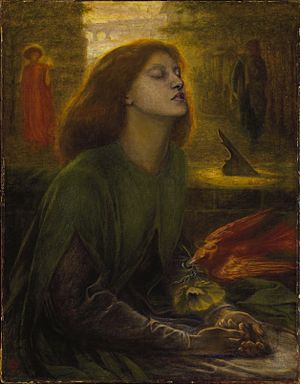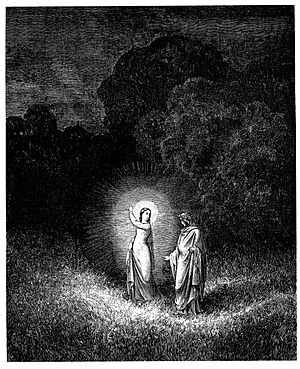Beatrice Portinari facts for kids
Quick facts for kids
Beatrice Portinari
|
|
|---|---|

|
|
| Born |
Beatrice di Folco Portinari
c.1265 Florence, Republic of Florence
|
| Died | 8 or 19 June 1290 (age 25) Florence, Republic of Florence
|
| Other names | Bice (birth name) |
| Known for | Inspiration for Dante Alighieri's Vita Nuova and Divine Comedy |
| Spouse(s) | Simone dei Bardi (m.1287) |
| Parent(s) | Father: Folco di Ricovero Portinari |
Beatrice (also known as Bice) di Folco Portinari was an Italian woman born around 1265 in Florence. She is famous for being the main inspiration for Dante Alighieri, a very important Italian poet.
Dante wrote about Beatrice in two of his most famous works: Vita Nuova and the Divine Comedy. In the Divine Comedy, Beatrice guides Dante through parts of the afterlife. She helps him understand divine grace and theology (the study of religious faith).
Contents
Beatrice's Life Story
Beatrice was the daughter of a rich banker named Folco Portinari. She later married another banker, Simone dei Bardi, in 1287.
Dante said he only met Beatrice twice in his life. These meetings were nine years apart. Yet, he was so deeply affected by her that he loved her throughout his life. Many scholars believe that Beatrice Portinari was indeed the woman Dante loved.
The first person to clearly say that Beatrice Portinari was Dante's Beatrice was Giovanni Boccaccio. He wrote about her in his comments on the Divine Comedy.
There isn't a lot of clear information about Beatrice's life. One important piece of evidence is her father Folco Portinari's will from 1287. In his will, he left money to his daughter, Bice, who was married to Simone dei Bardi. This shows that Beatrice Portinari was a real person.
Folco Portinari was a wealthy banker. He moved to Florence and lived near Dante's home. He had six daughters and was known for being very generous. He even helped start the Hospital of Santa Maria Nuova.
Beatrice in Dante's Books
For a long time, people have wondered if the real Beatrice Portinari was the same as the Beatrice in Dante's writings. Beatrice Portinari's life story generally fits. It's also very possible that she and Dante knew each other. However, the Beatrice in Dante's books seems to be more of a literary character. She might only share a few similarities with the real person.
Vita Nuova
Beatrice first appears in Dante's book La Vita Nuova, which he wrote around 1293. This book mixes poetry and prose (regular writing). It shows Beatrice and Dante's strong feelings for her. In Vita Nuova, Dante describes Beatrice in a very positive way. At this point, she is like a typical "courtly lady" from medieval stories. She doesn't yet have the very strong personality she shows in the Divine Comedy.
Dante wrote that he first met Beatrice when he was nine years old. His father took him to the Portinari house for a May Day party. Beatrice was a few months younger than him. Dante immediately felt a strong connection to her. He continued to feel this way throughout his life in Florence.
Even though Beatrice married Simone de' Bardi in 1287, Dante still felt something for her. Dante himself married Gemma Donati in 1285. Beatrice died in 1290. After her death, Dante studied intensely and began writing poems about her. These poems, along with others he had written before, became the Vita Nuova.
Dante expressed his love for Beatrice in a way called "courtly love". This was a common idea in the Middle Ages. Courtly love was often a secret, unreturned, and very respectful admiration for a lady. It was more of a literary idea than a real relationship. Sometimes, the lady didn't even know she had a courtly admirer. The admirer might not even want a real relationship. Instead, the lady was a subject for the lover to practice his poetry or discuss philosophy. This suggests that Dante's story of his love for Beatrice might be more literary than a direct copy of real life.
Divine Comedy
At the beginning of the Inferno, the poet Virgil appears to guide Dante through the afterlife. Virgil explains that Beatrice sent him. She was asked to help by the Virgin Mary and Saint Lucia. Beatrice is often mentioned during Dante's journey through hell and purgatory. She is a source of hope and comfort for him.
Beatrice herself appears near the end of the Purgatorio. She takes over as Dante's guide from Virgil. Virgil cannot enter Paradise because he was a pagan (not Christian). Beatrice, whose name means "she who blesses," is perfect for leading Dante into heaven.
Virgil represents human reason and philosophy. Beatrice represents religious knowledge and strong faith. She stands for theology, faith, deep thought, and grace. Philosophy can guide Dante through places of sin and repentance. But only divine faith can truly lead a soul to God.
When Beatrice appears to Dante in the Garden of Eden in Purgatorio, it's not a happy reunion at first. She scolds him for crying when Virgil leaves. She also tells him off for forgetting her after her death and falling into sin. She had to step in to save him.
As Beatrice guides Dante through the different levels of Heaven, she becomes more and more beautiful. This shows Dante's journey closer to God. She often corrects Dante during his journey. She acts as a spiritual guide and shares her wisdom. After her initial sternness, Beatrice becomes encouraging and patient with Dante in Paradiso. She is happy with his progress.
When they reach the highest heaven, the Empyrean, Beatrice leaves Dante. She takes her rightful place there. Saint Bernard then guides Dante for the very last part of his journey. He shows Dante where Beatrice sits in the Empyrean, among other important women from the Bible.
Dante compares Beatrice leading the Church's procession in the Garden to an admiral commanding a ship. This is an unusual comparison, using a masculine image for a courtly lady. Her discussions on many academic topics in Paradiso also differ from how courtly ladies were usually shown. They were usually objects of praise, not subjects of deep discussion. For example, she talks about optics (the study of light) and the scientific method. Beatrice is often seen as a Christ figure. This is because of her death, the "new life" Dante finds through her in La Vita Nuova, and her role in saving Dante's soul in the Comedy.
Beatrice's Legacy
Modern Art
Beatrice Portinari has been remembered not just in Dante's poems. She also appears in paintings by Pre-Raphaelite artists and poets in the 1800s. These artists were inspired by Dante Alighieri's La Vita Nuova, especially the idea of Beatrice as a perfect woman.
Dante Gabriel Rossetti created much art inspired by Beatrice in the 1850s. This was especially true after his wife, Elizabeth Siddal, died. He painted her as Dante's Beatrice in several works, like Beata Beatrix.

See also
- Dante and Beatrice (disambiguation)


